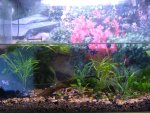IloveMyNewts
New member
- Joined
- Apr 11, 2008
- Messages
- 32
- Reaction score
- 1
- Points
- 0
- Country
- United States
So, I think it is time to upgrade my colony of CFBN to a 20 gallon, and I wanted to make it a biotope.
Does anyone know what type of plants grow in their native environment that I might find in the aquarium trade? What ecosystems do the wild caught specimens derive from? What is the water quality, PH, Temperature ranges, or Seasonal flooding?
Also, in addition to aquatic plants, what kind of plants would one find on the land haul outs?
Thanks.
Does anyone know what type of plants grow in their native environment that I might find in the aquarium trade? What ecosystems do the wild caught specimens derive from? What is the water quality, PH, Temperature ranges, or Seasonal flooding?
Also, in addition to aquatic plants, what kind of plants would one find on the land haul outs?
Thanks.

